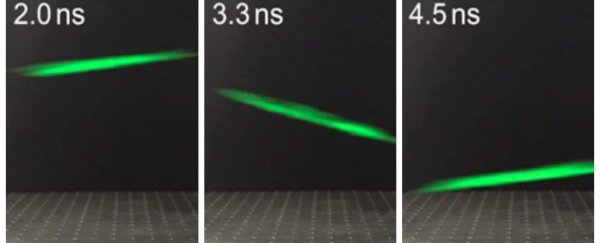For the first time ever, scientists have managed to film a laser flight path, and it looks like something straight out of the movies.
In order for us to see light, it needs to make contact with our eyes. What makes lasers so tricky to perceive is that they're made up of a single, sharply focussed beam, with each photon - or light particle - moving in the same direction. Only if enough photons happen to be deflected off-course and into our eyes by an obstruction, like smoke, will we ever even know that the laser's there.
But now a team of physicists led by Genevieve Gariepy from Heriot-Watt University in the UK have figured out how to see a bright green laser beam bouncing around their lab without ever interacting with it. They used a specially built super-high-speed camera, capable of detecting single photons at a time, and recorded 2 million laser pulses over a 10-minute period.
"The challenge was to have a movie of light moving directly in air," Gariepy told Jacob Aron from New Scientist. "We wanted to look at light without interacting with it, just looking at it passing by."
Aron reports that the camera was built using a 32-by-32 grid of photon detectors, which could record the light particles at a speed of around 20 billion frames a second. "The team arranged the camera to film a side-on view of a green laser firing at an arrangement of mirrors. By firing 2 million pulses over a 10 minute period and subtracting background noise, they were able to build up enough air-scattered photons in the camera to track the laser's path as it bounced."
So each frame the camera recorded and put together in the video above was the green laser light moving further and further through their mirror system.
Speaking with James Vincent at The Verge, Gariepy said that the "slightly smeared" look of the green laser shows off just how precise their camera is. "The pulse has a shape: it's not just a rectangle moving through the air," she said.
And we thought seeing lasers zoom vaguely through a Coke bottle in 2011 was as good as it gets:
Sources: New Scientist, The Verge
